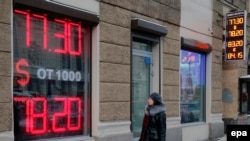A continued depreciation of the Russian ruble took a heavy financial toll on Armenia last year, cutting the country’s export revenue and especially multimillion-dollar remittances from Armenian migrant workers in Russia.
The ruble has lost more than half of its value against the U.S. dollar since international oil prices began rapidly falling in mid-2014. The Armenian national currency, the dram, has weakened by only about 20 percent, translating into significantly less revenue for local exporters oriented towards the Russian market.
According to the National Statistical Service (NSS), Armenian exports to Russia, most of them agricultural products and processed foodstuffs, tumbled by about 27 percent to $226 million in 2015. This was the main factor behind a 4 percent drop in the country’s overall exports that totaled almost $1.5 billion.
The much weaker ruble has also sharply lowered both the dollar-denominated and dram-denominated values of remittances sent home by hundreds of thousands of Armenian migrant workers.
Data from the Central Bank of Armenia (CBA) shows the total amount of non-commercial cash transfers from Russia processed by commercial banks falling, in dollar terms, by 36 percent to $916 million in 2015. The figure stood at $1.6 billion in 2013.
Russia continues to account for the lion’s share of overall remittances to Armenia that were equivalent to more than 10 percent of Gross Domestic Product in 2015.
The decreased remittance inflows explain why Armenian imports shrunk by 26.5 percent to $3.25 billion last year despite a GDP growth rate of roughly 3 percent registered by the authorities. Their impact is felt particularly acutely in rural regions of Armenia heavy dependent on agricultural exports, remittances and local residents’ seasonal work in Russia.
The southern Armavir province, home to many vineyards and fruit orchards, is a case point. Harutiun Harutiunian, a local resident, live offs rubles regularly sent by his son living in Russia. He can now buy nearly twice as less drams with them as two years ago.
“If he sends me, say, 30,000 rubles ($380) I get 180,000 drams ($365) less from them than I used to,” Harutiunian explained to RFE/RL’s Armenian service (Azatutyun.am).
Many other, younger residents of the rural area have long engaged in annual seasonal work in Russia, mostly in the construction sector. They too are now worse off than in 2014.
One of them, Khasem Aghayan, was very dissatisfied when he returned from Russia last fall. “I’m a bricklayer,” he said. “The money I brought home was worth nothing. They paid me 50,000 rubles a month. I paid off my debts to banks and the money was gone.”
“Last year, I didn’t go to Russia because the ruble’s exchange rate was very low,” said another Armavir villager. “It wasn’t worth it. You can get the same amount of money if you have a job here. So it’s better to stay here, in your country and with your family.”
Russia is also a key market for fruits and vegetables grown in Armavir. Farmers dependent on those exports too have been hard by the weaker ruble.
“Last year, villagers suffered many losses from [sales of] cherries and apricots,” said Andranik Yeghiazarian, a local trader selling farmers’ produce in Russia. “They were left with [no revenue] after paying for land, water and fertilizers and repaying loans.”





